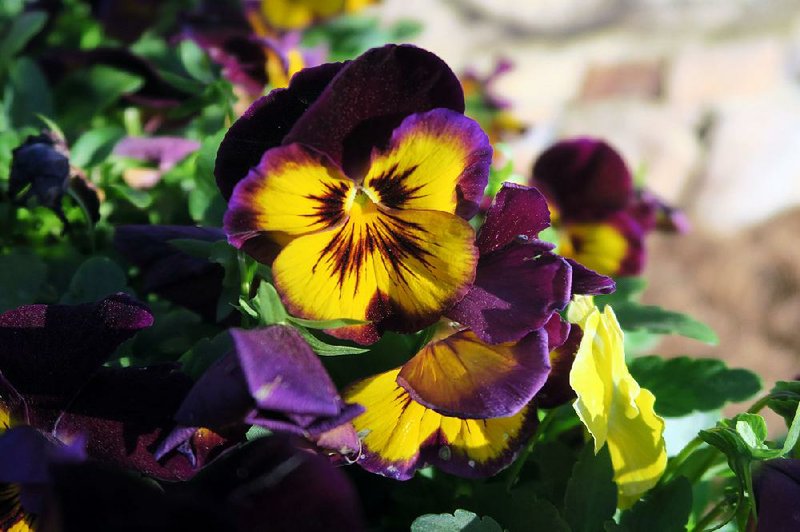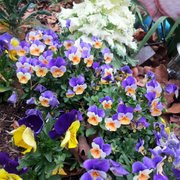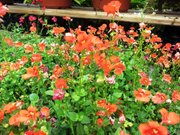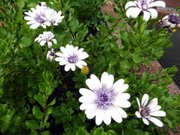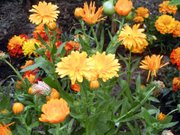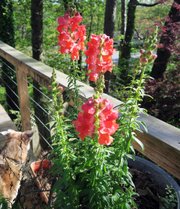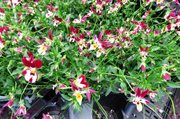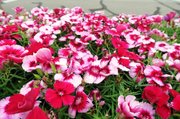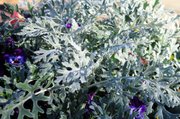Many of our gardens are showing more color than usual for the end of a growing season. Annuals reached new heights during this mild summer and are still growing strong.
If that's your garden, continue to enjoy your summer color.
But for those whose flowering annuals have gone by or who want to begin planning for their cool-season color, options are appearing at most nurseries and garden centers.
PANSIES
The staple cool-season annual is still the pansy. Pansies have been the No. 1 fall and winter bedding plant in the South for decades.
There is a wide array of colors to choose from and different flower sizes. The traditional flower has two looks -- with a black blotch or "face" and without. The ones not having that dark blotch in the center can be called "clear."
One of the newest innovations in pansies is the Cool Wave series, which have more of a sprawling habit than the older varieties.
Don't plant pansies too soon in late summer or early fall as they will get leggy quickly if exposed to high temperatures. On the other hand, do try to get them in the ground early enough in the fall to get a root system established before it gets really cold.
Whether pansies merely survive or thrive through winter depends on how much temperatures fluctuate and how low they go.
They do like nutrition, so fertilize periodically, even in the winter months.
VIOLAS
A kissing cousin of pansies is violas. While the flower size is smaller, they tend to bloom more prolifically from early fall through early summer, when the temperatures finally rise high enough to make them play out.
They are more tolerant of fluctuations in temperatures, especially high temps, so they often perform better in the South than pansies.
These are annuals with a wide array of flower colors and some interesting new varieties -- a new strap-petaled form called "Bunny Ears" and a highly ruffled form with many colors in the Frou series.
DIANTHUS
Dianthus are touted as annuals, biennials or short-lived perennials, but they have done well in our gardens all this year. Most survived the mild summer and are blooming again.
If you don't have any growing in your garden, consider planting some.
The flowers come in shades of pink, purple, red and white. There are single colors and multicolored options.
They bloom and rest, bloom and rest, off-and-on throughout the year. But they
shine in the cool days of fall.
They must have a well-drained soil if they are going to survive.
SNAPDRAGONS
Snapdragons have been surviving and blooming longer in Arkansas gardens. The annuals bloom best in the cool days of fall and spring but can produce flowers on mild winter and even on summer days.
With spikes of colors ranging from pink and red to yellow, white and orange, there are dwarf and standard varieties.
BROAD SHOULDERS
While all of the above should survive all winter in the garden, there are a few flowers that are called "shoulder blooms," giving brief but intense color in the fall or spring. They flower until the weather turns really cold, then die, or when it is really hot, then play out.
These can be the added boost your garden needs to create vibrant color combinations. Osteospermum, calendula, nemesia and diascia are some examples.
• Osteospermum, commonly called Cape daisy or daisy bush, is a beautiful flowering annual from Africa. While breeders are hard at work trying to build in heat tolerance, the plants still tend to fare best during fall and spring in Arkansas. There are many colors available, and some new flower forms with petals shaped like little spoons.
• Calendula is a great plant for fall color. Commonly called pot marigold, it comes in vibrant shades of orange, yellow and a new Flashback series with interesting color blends. It makes a good cut flower and is also considered an herb.
• Nemesia and diascia are native to South Africa and are in the snapdragon family. They thrive in lower temperatures.
Nemesia is a bit more upright than diascia but has a broader range of colors -- just about every color in the rainbow and a few vivid bi-colors.
Diascia is commonly called twin-spur. It is a low, spreading annual with larger flowers than nemesia. Diascia comes in white, pink and orange.
Both will tolerate light freezes but will succumb to a hard freeze.
BEYOND BLOOMS
While we often think of flowers for annual color, there are also a number of foliage plants of fall and winter interest.
Flowering kale and cabbage come in many colors, and Dusty Miller, with its dusty white foliage, can make the colors in your flowers stand out even more.
Ever heard the saying, "They look almost good enough to eat"? Well, these plants are edible.
Swiss chard comes in a wide array of foliage and stem colors, and there are a multitude of showy kale varieties, from the purplish red and curly "Redbor" kale and the bumpy, lance-leaved dinosaur kale ("Toscano") to blue-green and rippled "Winterbor" and the purple-stemmed "Red Russian."
If you like mustard greens, plant the giant purple mustard and "Bull's Blood" beets.
Try orange or purple cauliflower, purple and red cabbage and a grouping of different colored lettuce leaves.
Consider adding parsley and cilantro into your fall planting mix for some vibrant greens.
All of these plants are as colorful as they are edible. It's sort of like having your cake and eating it, too.
Every garden needs color in every season. As you begin to add fall and winter plants for color, look for something other than the same thing you used last year. You could find a new favorite.
Janet B. Carson is a horticulture specialist for the University of Arkansas Cooperative Extension Service.
HomeStyle on 09/16/2017
